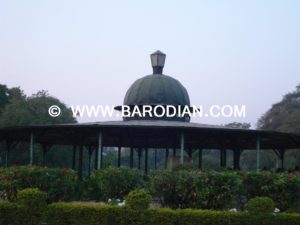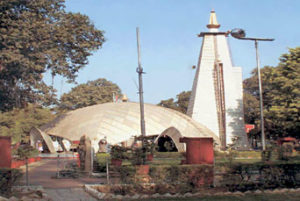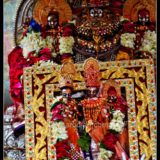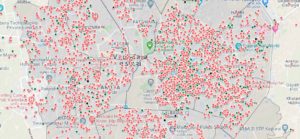1. Laxmi Vilas Palace

It was built by Shri Maharaja SayajiRao III. The first stone was laid by P.S. Melvill Esquire, C.S.I. Agent to the Governor General at Baroda, on the 12th Jan-1880 and and completed in 1890. It was built in the Indo-saracenic tradition, with an eclentic mix of of Indian, Islamic, and European Elements. It’s a residence of the royal family. Its, ornate Darbar Hall has an Italian mosaic floor and walls with mosaic decorations. The Palace houses a remarkable collection of old armoury and sculptures in bronze, marble and terracotta.
Location: Rajmahal Road
Visiting Hours: 9.30 am to 5.00 pm
Entry Fee: Rs. 225/- (per person), free entry for the kids below 10 yrs.
For Foreign Nationals: Rs. 400/-
Closed On: Monday
Note: Photography allowed from the outside of Palace.
Guide: They provide Mp3 Players with headphone to guide you during your visit. There is a guide facility is also available for big groups.
2. Sursagar Lake

Earlier it was known as Chandan Talao. Sursagar Lake is located in the city area of Vadodara. Its one of the largest man made lakes of Vadodara which is circular in shape and covers a circumference of one and a half mile. The lake is 60m deep which was built in the nineteenth century. Its surrounded by Nyaymandir and Lalcourt, and famous shopping market, Mangal Bazzar. A beautiful shivji Idol is placed in the center of the lake. During festivals and in night time the idol and lake is lightened up with beautiful lights and it’s a very pleasant view for visitors. After its renovation its now open to public in 2020. It also has a pathway around the lake where you and sit and enjoy the sunset and beautiful view of the lake.
3. Kirti Mandir

Kirti Mandir was built to commemorate the cremation of the members of the Gaekwad family. This “E” shaped large magnificent stone building with domes, terraces, balconies and central sikhara rising to about 33 meters. According to Sayaji Rao Gaekwad it was built to commemorate the benefactors of his state irrespective of their race, caste or creed. The construction cost is Rs. 50000/- and it preserves in its various rooms the statues and photographs of the members of the royal family. The Interior of this elegant structure is marble finished and on the wall of the central hall are the murals Gangavataran, battle of Mahabharata, Life of Meera and Natir Pooja-executed by the famous Bengali artist Nandalal Bose. It can be visited by everybody between 9 am to 12 pm and 2.30 pm to 5.30 pm.
4. Khanderao Market

This is palatial building erected by Sayaji Rao III in 1906-1907 at a cost of about Rs. 5 Lakhs. It was presented by him as a gift to the Municipality on the occasion of the Silver Jubilee Celebrations of his administration. The Municipal offices are located in this building. The Main entrance resembles in architecture with that of the gate of Dabhoi fort. Along with Municipal office, its now Vegetable market also.
5. Mandvi

This Imposing structure was built during the Mughal period and was restored in 1736 A.D. by the Governor Malharao Maloji under the orders of Damaji Rao II (1732 -1768 A.D.)
6. Sayaji Baug (Kamati Baug)

Sayaji Baug, is situated on river vishwamitri and was built by Sayaji Rao III in 1879. Sprawling over 113 acres, it also includes an excellent Zoo, the Baroda Museum and Picture Gallary, Sardar Patel Planetarium. A major attraction for children is the 3.5 kms joy ride through the park on the Toy Train. The Picture beside is the famous Bandstand in the Sayaji Baug.
7. Maharaja Fateh Singh Museum

Its located near Motibaug Cricket Ground in the Rajmahal so, when you visit the Rajmahal, do visit the Museum. It has the Royal Collection of arts and treasures with some great paintings of Shri Raja Ravi Verma.
Location: Beside Motibaug Cricket Ground, Near Baroda Cricket Association Office
Visiting Hours: 10.30 am to 05.30 pm
Entry Fee: Adult Rs. 30/- , Child Rs. 20/- (12 Yrs above)
Overseas Visitors: Rs. 100/-
Collective Tickets for School Group of 20 students Rs. 200/-
Closed On: Monday
Note: Photography Not Allowed
8. Baroda Museum & Picture Gallery

Baroda museum is considered to be one of the most famous museums of the country. The foundation stone of museum was laid in the year 1887 and the work completed in 1894. The Egyptian mummy and skeleton of a blue whale are major attractions for those who visit the museum. It has various room inside, like European room, Japanese Gallery, Chinese Gallery, Baroda room, etc.
The Picture gallery’s construction building started in 1908 and was completed in 1914 but the gallery could be opened only in 1921 as the world war delayed the transport of the collections of European paintings to Baroda-India.
Location: In Sayaji Baugh or Kamati Baugh
Visiting Hours: 10.30 am to 5.30 Pm (No Entry after 5.00 pm)
Entry Fee: Rs. 10/- (Above 4yrs of Age), Rs. 200/- for Foreigners, Rs. 5/- for Per Student for school groups.
Closed On: Important Public Holidays only
Note: Photography allowed on Camera fees Rs. 100/-
9. Tambekar Wada

It is located Near Raopura Area and it’s a 4 storey haveli was the residence of Diwan of Vadodara. This is famous for his wall paintings from the 19th century Maratha tradition depicting scenes from the Mahabharata, lord Krishna’s life and the Anglo-Maratha war.
10. Lehripura Gate

Laheripura gate is located near Nyaymandir and it’s a gateway of old city. It was built in 1558 and now a days this area is busy market place.
11. Nyay Mandir

Nyaymandir is a Temple of Justice. It’s a court house in Vadodara situated near Sursagar Lake. During festivals it’s all lightened up and its looks beautiful.
12. Sayaji Sarovar & Ajwa Nimeta

The Sayaji Sarovar or Ajwa Lake, 22 kms away from the city is the principal source of water. It is formed by damming the Surya river and vaghali nala. Work on the scheme was started in 1885 and was completed in 1890. The Gardens at Ajwa are patterned after the famous Brindavan Gardens of Mysore. The illumination of fountains is a major attraction for tourist.
13. Qutbuddin’s Tomb

Bulid around 1586, the tomb of Qutbuddin is the one of the oldest Moughal monuments of the city. Qutbuddin is the Army General of the great king Akbar.
Situated At: On Pratapnagar road, Just after the overbridge of Pratapnagar
14. Sri Aurobindo Ashram

Maharshi Aurobindo Ghosh, who one of the eminent freedom fighters and also a renouned philosopher resided in Vadodara from 1894 to 1906 as a private secretary to Maharaja Sayaji Rao Gaekwad. He also worked as vice principle and professor of English in Baroda college. His residence popularly known as Aurobindo Society is situated in Dandiya Bazaar area is the only national memorial.
Yoga and meditation are taught here regularly. Surrounded by a nicely manicured garden this magnificent building provides an opportunity to pass a few minutes in solace. Various useful articles prepared at Pondichery are sold in all emporiums on the ground floor. A nicely, displayed small museum on the life of Shri Aurobindo’s contribution can also be visited here.
15. Maharaja Sayajirao University

The Maharaja Sayajirao University of Baroda, originally know as Baroda college of science established in 1881, it became a university in 1949 after the independence of the country and later renamed after the benefactor Shri Maharaja Sayajirao Gaekwad III, the former ruler of Baroda. It is the only university in Gujarat whose medium of instruction is English for all courses.
16. EME Temple

The Indian army does not usually have separate places of worship for the different faiths, but this temple, built by the Electrical and Mechanical Engineering (EME) corps entirely out of aluminum sheets, worships Dakshinamurti, another name for Shiva as an ultimate teacher. This uncommonly modern-looking temple is, however, built with holy symbols from various religions. It is open from 6:30am-8:30pm. Photography is prohibited.












